药物不良反应信号检测
药品不良反应信号检测方法研究进展95
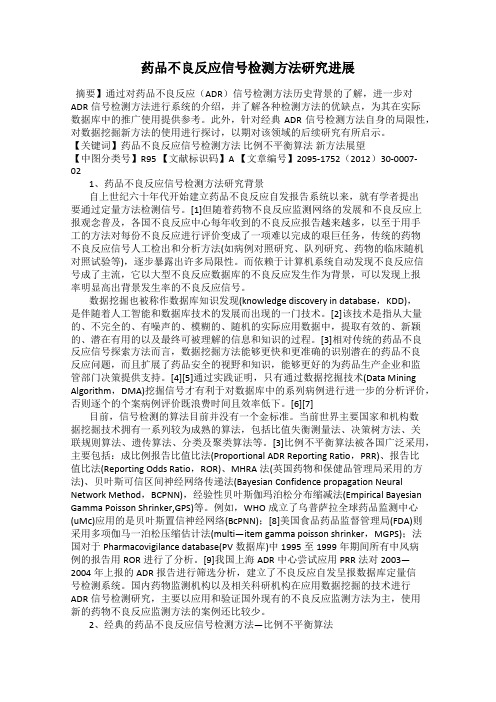
药品不良反应信号检测方法研究进展摘要】通过对药品不良反应(ADR)信号检测方法历史背景的了解,进一步对ADR信号检测方法进行系统的介绍,并了解各种检测方法的优缺点,为其在实际数据库中的推广使用提供参考。
此外,针对经典ADR信号检测方法自身的局限性,对数据挖掘新方法的使用进行探讨,以期对该领域的后续研究有所启示。
【关键词】药品不良反应信号检测方法比例不平衡算法新方法展望【中图分类号】R95 【文献标识码】A 【文章编号】2095-1752(2012)30-0007-021、药品不良反应信号检测方法研究背景自上世纪六十年代开始建立药品不良反应自发报告系统以来,就有学者提出要通过定量方法检测信号。
[1]但随着药物不良反应监测网络的发展和不良反应上报观念普及,各国不良反应中心每年收到的不良反应报告越来越多,以至于用手工的方法对每份不良反应进行评价变成了一项难以完成的艰巨任务,传统的药物不良反应信号人工检出和分析方法(如病例对照研究、队列研究、药物的临床随机对照试验等),逐步暴露出许多局限性。
而依赖于计算机系统自动发现不良反应信号成了主流,它以大型不良反应数据库的不良反应发生作为背景,可以发现上报率明显高出背景发生率的不良反应信号。
数据挖掘也被称作数据库知识发现(knowledge discovery in database,KDD),是伴随着人工智能和数据库技术的发展而出现的一门技术。
[2]该技术是指从大量的、不完全的、有噪声的、模糊的、随机的实际应用数据中,提取有效的、新颖的、潜在有用的以及最终可被理解的信息和知识的过程。
[3]相对传统的药品不良反应信号探索方法而言,数据挖掘方法能够更快和更准确的识别潜在的药品不良反应问题,而且扩展了药品安全的视野和知识,能够更好的为药品生产企业和监管部门决策提供支持。
[4][5]通过实践证明,只有通过数据挖掘技术(Data Mining Algorithm,DMA)挖掘信号才有利于对数据库中的系列病例进行进一步的分析评价,否则逐个的个案病例评价既浪费时间且效率低下。
药品安全信号检测程序文件

目的:建立药品安全信号检测程序。
适用范围:适用药品安全信号检测。
负责人:药品不良反应监测办公室主任、质量保证部部长、科研中心监测人员。
内容:及时发现信号,科学分析和评估信号是药品不良反应监测工作重要工作内容。
一、信号特征潜在安全性信号的特征包括药品说明书未标明的新的不良反应,特别是严重不良反应;药品说明书已标识的不良反应的严重程度明显增加;普通人群中异常罕见的不良反应;新的药品与药品、药品与器械、药品与食物、或药品与营养补充剂之间的相互作用;发现特定的危险人群〔例如,特定种族或基因易感性或并存疾病的人群;产品名称、标签、包装或使用上的混乱;不合理使用问题〔例如,不良反应见于超出产品说明书的推荐剂量、非推荐用药人群使用等。
二、信号检测可根据不良反应报告数量等因素,决定信号检测的方法。
1、个例病例评价:来自各种来源的个例报告可以形成潜在信号的早期预警。
个例报告的数量和质量会影响到评价结果。
一个单独的病例很少被考虑为信号。
对于新的不良反应通常需要对累积数据进行检索和分析,以确定是否代表一个潜在的新的信号。
2、病例报告系统回顾:为了及时发现风险信号,应该定期对收到的病例报告进行系统回顾。
回顾频率主要考虑一定时间内收到的ADR信息数量、产品类型等。
可以通过传统的人工经验开展病例报告系统回顾,也可以利用计算机辅助的数据挖掘方法进行病例报告系统回顾。
传统方法即人工通过分析一定时间内ADR信息情况的趋势变化,发现药品风险信息。
分析内容通常包括报告数量、患者人口统计学特征、原患疾病、不良反应表现、药品用法用量、批号、不良反应结果等。
计算机辅助的数据挖掘通常采用频数法、贝叶斯方法等。
从传统的个例报告的评价,到使用计算机算法对数据库中药品安全数据进行挖掘,每一种方法都有其优点和缺点。
个例报告评价可以全面评价报告的每一个方面,但是这就需要大量的资源。
而数据挖掘方法通过不良反应数量累加或者频次的分析可能会出现很多信号,需要人工进一步去分析,例如是否为已知不良反应,是否受销售量的影响等。
药品不良反应信号检测中的关联规则

As o it n Rue e Su v i n e o v r e Dr g Re c in Si n l D t c in s c a i ls i t r e l c f o nh l a Ad e s u a t g as e e t o o
中国药物警戒第 7卷第 3期
21 0 0年 3月
Mac , 0 0 V / , o3 r1 文献标识码: 文章编号 :6 2 8 2 (0 0)3 0 4 — 3 R 5R 9 .1 A 17 — 69 2 1 0- 15 0
药 品不 良反应信号检测中的关联规则
事件 ” “P 到 P A事件 ”药 品不 良反应 (de e rg eco , , avr u at n sd r i A R) D 已成为 全 世界共 同关 注 的问题 。 程 【。 D 处 理 过 程 分 为 9 阶段 , 数 据 挖 掘 (a 2 KD 1 个 而 dt a m n g, M) i n D 则是 K D过 程 中最重 要 的环 节 。 M 是 指 i D D
自上世纪中叶开始 , 大量新研制的药品为保障人类 b eK D)是近年来随着人工智能和数据库技术 的发 s a ,D ,
指 身体健康做 出了积极贡献。 但是药品在防病治病的同时 展 而 出现 的一 门新 兴 技术 , 从大 量数 据 中提 取 出可 信
也难免会发生不良反应。 从上世纪震惊全球的“ 沙利度安 的、 新颖的、 有效 的, 并能被人理解的模式的高级处理过
王超 叶小飞 钱维 贺佳 ( 第二军医大学卫生勤务系卫生统计学教研室 , 上海 20 3 ) 043 摘要 : 药品不良反应信号检测已成为药物警戒 的重要 内容 。随着 自发呈报系统应用的成熟 , 对数据库中的知识发现 的要求也逐渐提高。通过分析 目前常用信号检测方法的缺陷 , 介绍关联规则的概念与算法 , 探讨其在药品不 良反应 监测 中数据挖掘的可行性与独特优势。
药品不良反应信号检测方法概述
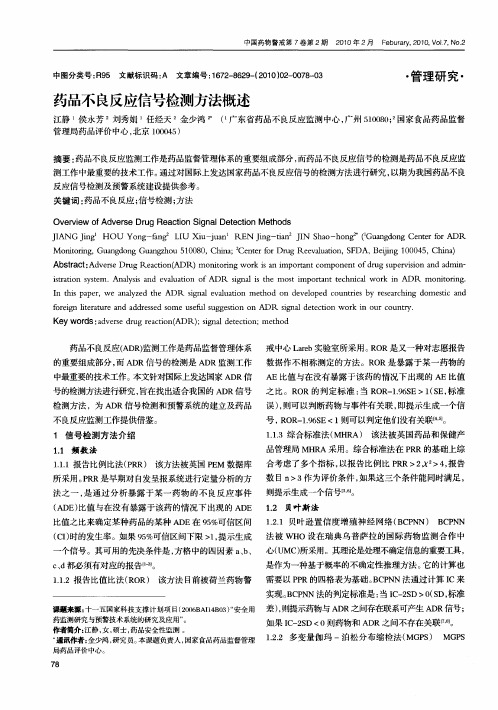
1 信 号检测方法介绍
11 频 数 法 .
以报告比例比 P R> > , R 2 4 报告 1. .1报告比例比法(R 1 P R) 该方法被英国 P M数据库 合考虑了多个指标 , E > 作为评价条件 , 如果这三个条件能同时满足 , 所采用。 R P R是早期对 自发呈报系统进行定量分析的方 数 目n 3 6 。 法之一 , 是通过分析暴露于某一药物的不 良反应事件 则提示生成一个信号 1
( D )k A E  ̄值与在没有暴露于该药的情况下 出现的 A E 1 贝叶 斯 法 D . 2
比值之比来确定某种药品的某种 A E在 9 %可信区间 1 . D 5 . 1贝叶逊置信度增殖神经 网络( C N 2 B P N) B P N CN ( I时的发生率。如果 9 % C) 5 可信 区间下限 > , 1提示生成 法被 WH O设在瑞典乌普萨拉的国际药物监 测合作 中
测工作中最重要的技术工作。 通过对 国际上发达国家药品不 良反应信号的检测方法进行研究, 以期为我国药品不良
反应信号检测及预警系统建设提供参考 。 关键词 : 药品不良反应 ; 信号检测; 方法
Ov r iw f v re Dr g Re c i n S g a t c in Me h d e ve o Ad e s u a t i n l o De e t t o s o
中国药物警戒第 7 第 2期 卷
2 0年 2月 F b rrFra bibliotek 0 0 V 1 , o2 01 e uay 2 1 , o. N . 7
中 分 号R5 文 标 码: 章 号 1 2 6 一 0 )— 7 0 图类 : 献识 A 9 文 编 :7 8 9 2 0 0 8 3 —2 (1 20 — 6 0
药品不良反应信号检测中遮蔽效应的影响及消除方法
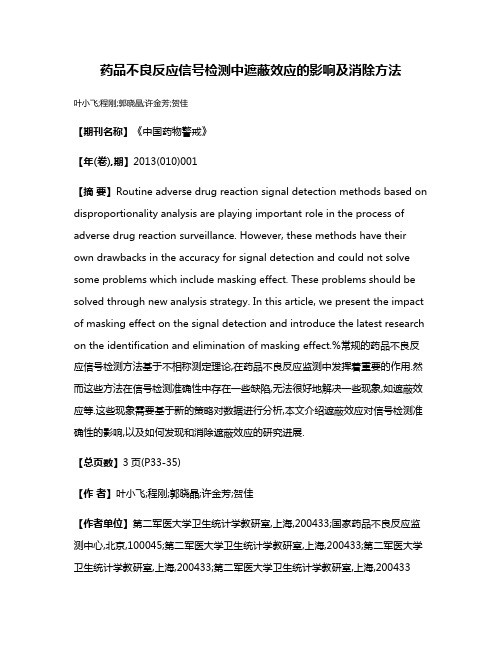
药品不良反应信号检测中遮蔽效应的影响及消除方法叶小飞;程刚;郭晓晶;许金芳;贺佳【期刊名称】《中国药物警戒》【年(卷),期】2013(010)001【摘要】Routine adverse drug reaction signal detection methods based on disproportionality analysis are playing important role in the process of adverse drug reaction surveillance. However, these methods have their own drawbacks in the accuracy for signal detection and could not solve some problems which include masking effect. These problems should be solved through new analysis strategy. In this article, we present the impact of masking effect on the signal detection and introduce the latest research on the identification and elimination of masking effect.%常规的药品不良反应信号检测方法基于不相称测定理论,在药品不良反应监测中发挥着重要的作用.然而这些方法在信号检测准确性中存在一些缺陷,无法很好地解决一些现象,如遮蔽效应等.这些现象需要基于新的策略对数据进行分析,本文介绍遮蔽效应对信号检测准确性的影响,以及如何发现和消除遮蔽效应的研究进展.【总页数】3页(P33-35)【作者】叶小飞;程刚;郭晓晶;许金芳;贺佳【作者单位】第二军医大学卫生统计学教研室,上海,200433;国家药品不良反应监测中心,北京,100045;第二军医大学卫生统计学教研室,上海,200433;第二军医大学卫生统计学教研室,上海,200433;第二军医大学卫生统计学教研室,上海,200433【正文语种】中文【中图分类】R954【相关文献】1.随机森林倾向性评分方法及其在药品不良反应信号检测中的应用 [J], 张新佶;张天一;许金芳;叶小飞;钱维;贺佳2.药品不良反应信号检测中混杂因素的控制方法 [J], 钱维;叶小飞;王超;贺佳3.不同信号检测方法在我国药品不良反应自发呈报系统中的应用 [J], 江静;侯永芳;刘秀娟;任经天;金少鸿4.论心电信号检测中的噪声与干扰及其消除方法 [J], 张欣春5.基于混合模型的药品不良反应数据遮蔽效应消除方法研究 [J], 魏建香;张剑吟;刘美含;李明;孙骏;徐厚明因版权原因,仅展示原文概要,查看原文内容请购买。
药品不良反应聚集性事件报告和处理标准操作程序及检测记录
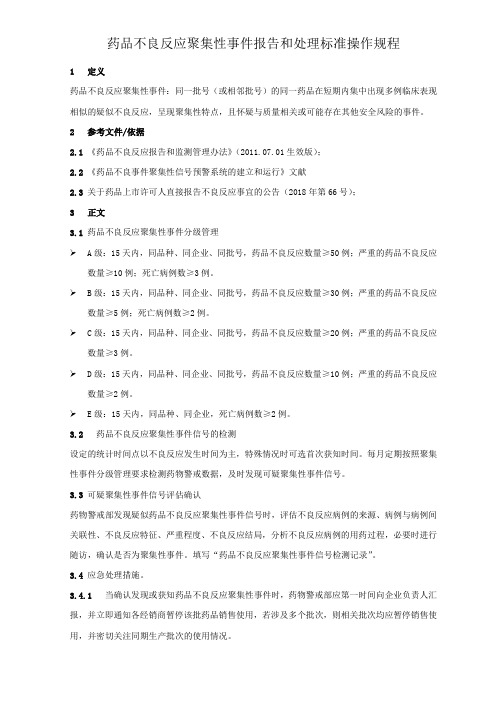
1定义药品不良反应聚集性事件:同一批号(或相邻批号)的同一药品在短期内集中出现多例临床表现相似的疑似不良反应,呈现聚集性特点,且怀疑与质量相关或可能存在其他安全风险的事件。
2参考文件/依据2.1《药品不良反应报告和监测管理办法》(2011.07.01生效版);2.2《药品不良事件聚集性信号预警系统的建立和运行》文献2.3关于药品上市许可人直接报告不良反应事宜的公告(2018年第66号);3正文3.1药品不良反应聚集性事件分级管理➢A级:15天内,同品种、同企业、同批号,药品不良反应数量≥50例;严重的药品不良反应数量≥10例;死亡病例数≥3例。
➢B级:15天内,同品种、同企业、同批号,药品不良反应数量≥30例;严重的药品不良反应数量≥5例;死亡病例数≥2例。
➢C级:15天内,同品种、同企业、同批号,药品不良反应数量≥20例;严重的药品不良反应数量≥3例。
➢D级:15天内,同品种、同企业、同批号,药品不良反应数量≥10例;严重的药品不良反应数量≥2例。
➢E级:15天内,同品种、同企业,死亡病例数≥2例。
3.2药品不良反应聚集性事件信号的检测设定的统计时间点以不良反应发生时间为主,特殊情况时可选首次获知时间。
每月定期按照聚集性事件分级管理要求检测药物警戒数据,及时发现可疑聚集性事件信号。
3.3可疑聚集性事件信号评估确认药物警戒部发现疑似药品不良反应聚集性事件信号时,评估不良反应病例的来源、病例与病例间关联性、不良反应特征、严重程度、不良反应结局,分析不良反应病例的用药过程,必要时进行随访,确认是否为聚集性事件。
填写“药品不良反应聚集性事件信号检测记录”。
3.4应急处理措施。
3.4.1当确认发现或获知药品不良反应聚集性事件时,药物警戒部应第一时间向企业负责人汇报,并立即通知各经销商暂停该批药品销售使用,若涉及多个批次,则相关批次均应暂停销售使用,并密切关注同期生产批次的使用情况。
3.4.2发出相关通知的同时,药物警戒部应立即通过电话或传真的方式报告市级药品监督管理局和省级药品监督管理局,有重要进展时应跟踪报告。
药品不良反应信号检测中的Meta分析

究 , t分析应用于药品不良反应有其独特优势 。通过介绍 Me 分析的概念、 Me a t a 研究步骤 , 结合噻唑烷二酮类药物引
起的心血管事件 、 药品不良反应发生率及种族差异问的 Me 分析实例 , t a 指出在药品不良反应信号检测的 Me 分析 t a 时, 应注意灵敏度分析、 亚组分析及选择正确的模型。
sv rl x mpe n ldn ado ac l v nscue y TZ , h n ie c f d e e du ecin ( DR)i e ea e a lsicu ig cr v sua e e t asd b Ds t eicd n e o v r r grat sA i r a s o n
关键词 : t me a分析 ; 品不 良反应 药
Ap i t n o pl i h v s u a t g al t c in n y i n t e Ad ere Dr g Re c i Sin on De e t o
Y a — e q[u e HEJa ( e at n f at ttt sF c l f a hS rie S c n layMeia E Xio fi t- W i 【 prme t Hel Sai i , aut o Hel evc , e o dMitr dcl 4 i ) o h sc y t i
tg s n t i at l e g v re r d cin a o tt o c pt tp b u ea n ls .And a o iu tae a e.I h s ri e w a e a b fi o u t b u he c n e ,se sa o tm t —a ay i c i nt o s l l srtd s l
h s i l e ain sa d eh i fee e n rs so d e e ra to .I d i o o pt i d p t t n t n c d rnc si k fa v r e c ns n a d t n,we as u g se h tsn i v az e i i s i i o s g etd t a e st e l i a lss u nayi,s b—g o p a ay i a d m o e ee t n s o l o e in r d whl p lig M ea n y i i r u n lss n d lslci h u d n tb g o e i a pyn t—a a s n AD R.s a o e l s i l n g d tci n ee to .
基于自发呈报系统药品不良反应信号检测方法的研究进展_李苑雅
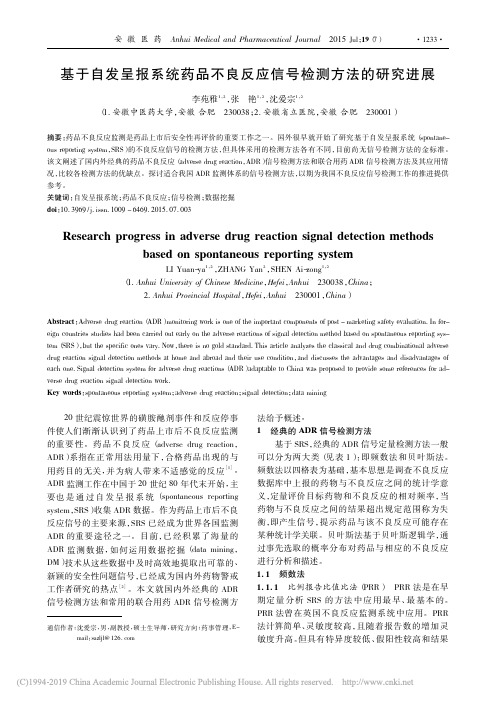
基于自发呈报系统药品不良反应信号检测方法的研究进展李苑雅1,2,张艳1,2,沈爱宗1,2(1.安徽中医药大学,安徽合肥230038;2.安徽省立医院,安徽合肥230001)摘要:药品不良反应监测是药品上市后安全性再评价的重要工作之一。
国外很早就开始了研究基于自发呈报系统(spontane-ous reporting system ,SRS )的不良反应信号的检测方法,但具体采用的检测方法各有不同,目前尚无信号检测方法的金标准。
该文阐述了国内外经典的药品不良反应(adverse drug reaction ,ADR)信号检测方法和联合用药ADR信号检测方法及其应用情况,比较各检测方法的优缺点。
探讨适合我国ADR监测体系的信号检测方法,以期为我国不良反应信号检测工作的推进提供参考。
关键词:自发呈报系统;药品不良反应;信号检测;数据挖掘doi :10.3969/j.issn.1009-6469.2015.07.003Research progress in adverse drug reaction signal detection methodsbased on spontaneous reporting systemLI Yuan-ya 1,2,ZHANG Yan 2,SHEN Ai-zong 1,2(1.Anhui University of Chinese Medicine ,Hefei ,Anhui 230038,China ;2.Anhui Provincial Hospital ,Hefei ,Anhui 230001,China )Abstract :Adverse drug reaction (ADR)monitoring work is one of the important components of post -marketing safety evaluation.In for-eign countries studies had been carried out early on the adverse reactions of signal detection method based on spontaneous reporting sys-tem (SRS ),but the specific ones vary.Now ,there is no gold standard.This article analyzes the classical and drug combinational adverse drug reaction signal detection methods at home and abroad and their use condition ,and discusses the advantages and disadvantages of each one.Signal detection system for adverse drug reactions (ADR)adaptable to China was proposed to provide some references for ad-verse drug reaction signal detection work.Key words :spontaneous reporting system ;adverse drug reaction ;signal detection ;data mining通信作者:沈爱宗,男,副教授,硕士生导师,研究方向:药事管理,E-mail :sazljl@126.com20世纪震惊世界的磺胺酏剂事件和反应停事件使人们渐渐认识到了药品上市后不良反应监测的重要性。
药品安全性信号检测、评价及控制管理sop
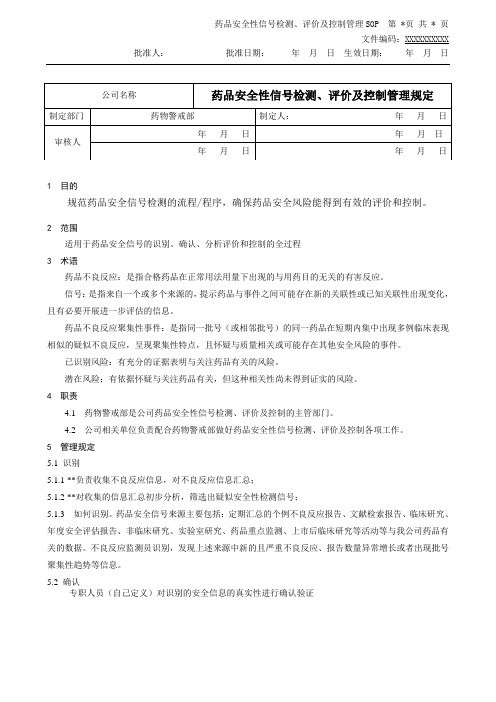
1 目的规范药品安全信号检测的流程/程序,确保药品安全风险能得到有效的评价和控制。
2 范围适用于药品安全信号的识别、确认、分析评价和控制的全过程3 术语药品不良反应:是指合格药品在正常用法用量下出现的与用药目的无关的有害反应。
信号:是指来自一个或多个来源的,提示药品与事件之间可能存在新的关联性或已知关联性出现变化,且有必要开展进一步评估的信息。
药品不良反应聚集性事件:是指同一批号(或相邻批号)的同一药品在短期内集中出现多例临床表现相似的疑似不良反应,呈现聚集性特点,且怀疑与质量相关或可能存在其他安全风险的事件。
已识别风险:有充分的证据表明与关注药品有关的风险。
潜在风险:有依据怀疑与关注药品有关,但这种相关性尚未得到证实的风险。
4 职责4.1 药物警戒部是公司药品安全性信号检测、评价及控制的主管部门。
4.2 公司相关单位负责配合药物警戒部做好药品安全性信号检测、评价及控制各项工作。
5 管理规定5.1 识别5.1.1 **负责收集不良反应信息,对不良反应信息汇总;5.1.2 **对收集的信息汇总初步分析,筛选出疑似安全性检测信号;5.1.3 如何识别。
药品安全信号来源主要包括:定期汇总的个例不良反应报告、文献检索报告、临床研究、年度安全评估报告、非临床研究、实验室研究、药品重点监测、上市后临床研究等活动等与我公司药品有关的数据。
不良反应监测员识别,发现上述来源中新的且严重不良反应、报告数量异常增长或者出现批号聚集性趋势等信息。
5.2 确认专职人员(自己定义)对识别的安全信息的真实性进行确认验证5.2.1 定性信号检测主要按照5.1.3规定的原则结合公司产品安全性特征的实际情况进行规定;5.2.2 定量信号检测主要按照5.1.3规定的原则结合公司个例报告收集的实际情况进行规定;5.3 分析评价不良反应监测专职人员同有关部门对识别的药品安全信息进行分析评价,如果经分析发现一个或更多的病例都在提示一个安全性信号,监测员要对信号做进一步的调查分析和病例汇总分析。
药品安全信号检测标准操作规程
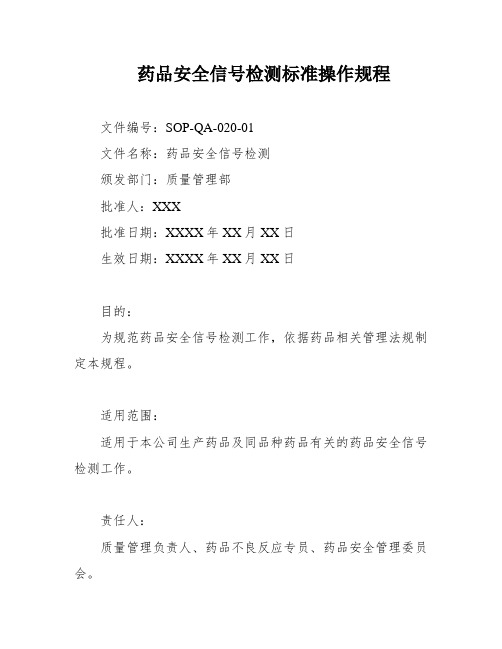
药品安全信号检测标准操作规程文件编号:SOP-QA-020-01文件名称:药品安全信号检测颁发部门:质量管理部批准人:XXX批准日期:XXXX年XX月XX日生效日期:XXXX年XX月XX日目的:为规范药品安全信号检测工作,依据药品相关管理法规制定本规程。
适用范围:适用于本公司生产药品及同品种药品有关的药品安全信号检测工作。
责任人:质量管理负责人、药品不良反应专员、药品安全管理委员会。
程序:1.概念1.1 信号信号是从一个或多个来源(包括观察和试验)产生的信息,提示干预措施与某个或某类不良或有利事件之间存在一种新的潜在的因果关系,或某已知关联的新的方面,这样的信息被认为值得进一步验证。
1.2 药品安全信号药品安全信号是指药品从一个或多个来源(包括观察和试验)产生的安全方面的信息,提示干预措施与某个或某类不良或有利事件之间存在一种新的潜在的因果关系,或某已知关联的新的方面。
2.药品安全信号管理2.1 信号发现2.1.1 传统检测方法传统检测方法包括人工发现信息,如药品不良反应/事件报告表、定期汇总报告、聚集性事件、文献资料、相关研究报告等。
2.1.2 数据挖掘的统计学方法数据挖掘的统计学方法是指计算机辅助信号挖掘,包括数据挖掘算法如比值失衡测量、不相称性测定等。
通过数据挖掘技术检出的信号需要基于报告的数量关联或统计学关联、非生物学关联(药品情况、患者情况、合并使用情况等)。
SDR成为真正的信号,还需要严禁的信号评价过程。
2.1.3 数据和相关的假设最重要的是数据和相关的假设:是否完整、是否经过确认、是否一致,要检查、检查、再检查。
2.2 信号检测方法2.2.1 频数法频数法包括报告比例比法、报告比值比法、综合标准法等。
2.2.2 ___贝叶斯法包括___置信度可信区间递进神经网络模型、多变量-泊松分布缩减法等。
3.信号确认4.信号处理以上是药品安全信号检测的基本流程。
在具体实施中,需要由质量管理负责人、药品不良反应专员、药品安全管理委员会等责任人负责监督和执行。
药物警戒信号检测的原理
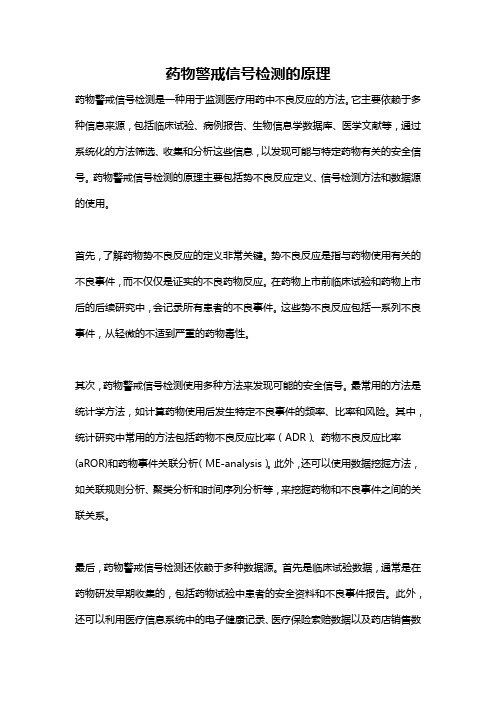
药物警戒信号检测的原理药物警戒信号检测是一种用于监测医疗用药中不良反应的方法。
它主要依赖于多种信息来源,包括临床试验、病例报告、生物信息学数据库、医学文献等,通过系统化的方法筛选、收集和分析这些信息,以发现可能与特定药物有关的安全信号。
药物警戒信号检测的原理主要包括势不良反应定义、信号检测方法和数据源的使用。
首先,了解药物势不良反应的定义非常关键。
势不良反应是指与药物使用有关的不良事件,而不仅仅是证实的不良药物反应。
在药物上市前临床试验和药物上市后的后续研究中,会记录所有患者的不良事件。
这些势不良反应包括一系列不良事件,从轻微的不适到严重的药物毒性。
其次,药物警戒信号检测使用多种方法来发现可能的安全信号。
最常用的方法是统计学方法,如计算药物使用后发生特定不良事件的频率、比率和风险。
其中,统计研究中常用的方法包括药物不良反应比率(ADR)、药物不良反应比率(aROR)和药物事件关联分析(ME-analysis)。
此外,还可以使用数据挖掘方法,如关联规则分析、聚类分析和时间序列分析等,来挖掘药物和不良事件之间的关联关系。
最后,药物警戒信号检测还依赖于多种数据源。
首先是临床试验数据,通常是在药物研发早期收集的,包括药物试验中患者的安全资料和不良事件报告。
此外,还可以利用医疗信息系统中的电子健康记录、医疗保险索赔数据以及药店销售数据等进行药物警戒信号检测。
此外,还有一些特定的数据库可以用于药物警戒信号检测,如美国FDA的药物事件报告系统(FAERS)和世界卫生组织的全球药物监测计划(VigiBase)等。
在进行药物警戒信号检测时,需要将不同数据源中的信息整合,进行数据清洗和规范化处理,以消除数据的噪音和不一致性。
然后,可以使用适当的统计或数据挖掘方法来分析数据,发现可能的安全信号。
发现安全信号后,通常需要进一步验证和评估,包括在更大的人群中进行观察性研究或进行其他实验研究。
总之,药物警戒信号检测是一种通过多种方法和多种数据源来发现与特定药物安全相关的信息的方法。
药品不良反应监测中的数据分析方法
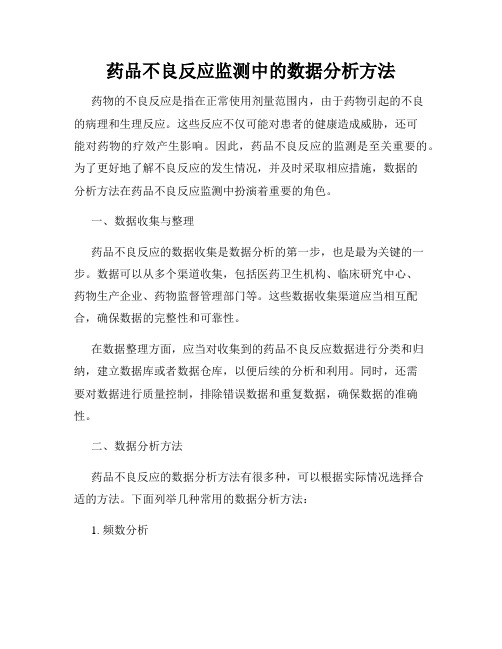
药品不良反应监测中的数据分析方法药物的不良反应是指在正常使用剂量范围内,由于药物引起的不良的病理和生理反应。
这些反应不仅可能对患者的健康造成威胁,还可能对药物的疗效产生影响。
因此,药品不良反应的监测是至关重要的。
为了更好地了解不良反应的发生情况,并及时采取相应措施,数据的分析方法在药品不良反应监测中扮演着重要的角色。
一、数据收集与整理药品不良反应的数据收集是数据分析的第一步,也是最为关键的一步。
数据可以从多个渠道收集,包括医药卫生机构、临床研究中心、药物生产企业、药物监督管理部门等。
这些数据收集渠道应当相互配合,确保数据的完整性和可靠性。
在数据整理方面,应当对收集到的药品不良反应数据进行分类和归纳,建立数据库或者数据仓库,以便后续的分析和利用。
同时,还需要对数据进行质量控制,排除错误数据和重复数据,确保数据的准确性。
二、数据分析方法药品不良反应的数据分析方法有很多种,可以根据实际情况选择合适的方法。
下面列举几种常用的数据分析方法:1. 频数分析频数分析是最简单直接的数据分析方法,通过统计每种不良反应的发生次数,了解不良反应的发生率和分布情况。
可以使用柱状图或饼图等可视化的手段,直观地展示不同不良反应的发生情况。
2. 时序分析时序分析是通过时间的变化来分析药品不良反应的趋势和规律。
可以使用线图或者散点图等图表,表达药品不良反应发生的时间趋势和相关性。
3. 关联规则分析关联规则分析是通过挖掘不同药品不良反应之间的关联关系,发现药品的联合使用可能引发特定的不良反应。
可以使用关联规则挖掘算法,从大量的数据中找出频繁项集和关联规则,帮助医生和药物监管部门预防药品不良反应的发生。
4. 信号检测方法信号检测是通过分析药物使用过程中的异常信号,发现与药物不良反应有关的信息。
可以使用统计学方法,如Bayesian监测方法或者计算机辅助算法,对药品不良反应的信号进行有效筛选和识别。
5. 风险评估方法风险评估方法是通过将不良反应的严重程度和患者的暴露程度进行综合评估,来判断药物的安全性和风险程度。
药品不良反应数据处理及安全性信号检测操作规程
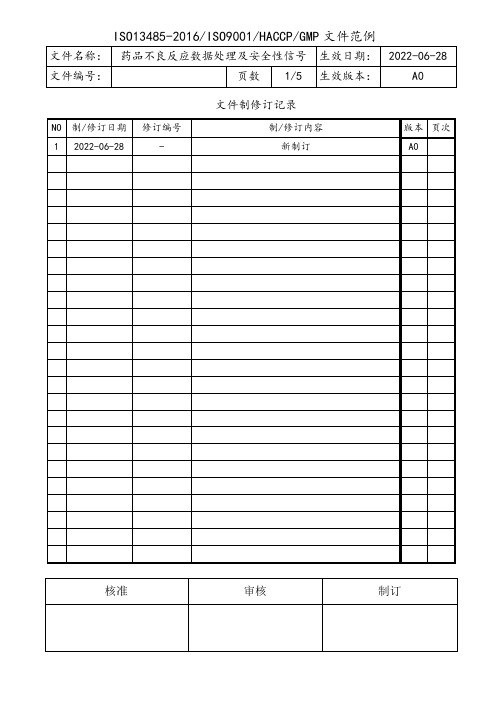
文件制修订记录一、目的对收集到的不良反应报告数据进行汇总分析,深入挖掘潜在的药品安全风险和可能的药品质量风险,并对发现的问题采取针对性的措施,减少和防止药品不良反应重复发生。
二、适用范围本职责适用于药品不良反应报告及监测工作开展的相关人员及岗位。
三、定义1、信号:从一个或多个来源(包括观察和试验)产生的信息,提示干预措施与某个或某类、不良或有利事件之间存在一种新的潜在的因果关系,或某已知关联的新的方面,这样的信息被认为值得进一步验证。
2、药品安全信号:是指药品从一个或多个来源(包括观察和试验)产生的安全方面的信息,提示干预措施与某个或某类、不良或有利事件之间存在一种新的潜在的因果关系,或某已知关联的新的方面。
四、内容1、不良反应监测部应将个例药品不良反应信息以数据库的形式管理,便于查找、分析和评价,通过EXCEL表格的形式建立本公司药品不良反应数据库。
已提交的药品不良反应报告表应能追溯到原始记录、随访记录及调查报告。
2、为保证数据的安全性和保密性,应对数据库实行加密管理。
登录密码应严格保密,同时应避免因人员更替而导致密码的遗失。
数据库中的数据每个月备份一次,并保存在性能良好的电脑或存储介质中,电脑应进行维护,防止因设备损坏或淘汰造成数据的丢失。
3、不良反应监测部应将收集到的每例不良反应均纳入数据库中进行管理,对于剔除的不良反应应进行备注说明,解释剔除原因。
对于从国家药品生产企业直报监测系统中下载的不良反应,认为其数据类型描述不准确的,也应进行备注解释。
4、不良反应监测部应每月对上个月的药品不良反应数据进行回顾分析,对不良反应个例总数、新的不良反应个例数、新的且严重的不良反应个例数、死亡病例数及其占比进行统计,填写《药品不良反应数据月处理台账》,并入不良反应数据库中。
发现以上不良反应数目或其占比出现明显增加趋势时,应对信号做进一步的调查分析。
5、药物安全性信号的筛选和确认5.1 信号筛选和确认的原则:新信号或已知信号频率、持续时间、严重程度发生变化。
不良反应ADR监测方法、原理、流程
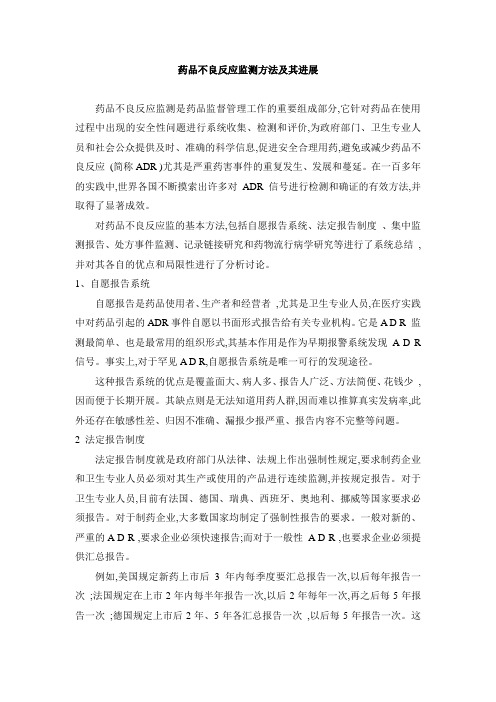
药品不良反应监测方法及其进展药品不良反应监测是药品监督管理工作的重要组成部分,它针对药品在使用过程中出现的安全性问题进行系统收集、检测和评价,为政府部门、卫生专业人员和社会公众提供及时、准确的科学信息,促进安全合理用药,避免或减少药品不良反应(简称ADR )尤其是严重药害事件的重复发生、发展和蔓延。
在一百多年的实践中,世界各国不断摸索出许多对ADR信号进行检测和确证的有效方法,并取得了显著成效。
对药品不良反应监的基本方法,包括自愿报告系统、法定报告制度、集中监测报告、处方事件监测、记录链接研究和药物流行病学研究等进行了系统总结,并对其各自的优点和局限性进行了分析讨论。
1、自愿报告系统自愿报告是药品使用者、生产者和经营者,尤其是卫生专业人员,在医疗实践中对药品引起的ADR事件自愿以书面形式报告给有关专业机构。
它是A D R 监测最简单、也是最常用的组织形式,其基本作用是作为早期报警系统发现 A D R 信号。
事实上,对于罕见A D R,自愿报告系统是唯一可行的发现途径。
这种报告系统的优点是覆盖面大、病人多、报告人广泛、方法简便、花钱少,因而便于长期开展。
其缺点则是无法知道用药人群,因而难以推算真实发病率,此外还存在敏感性差、归因不准确、漏报少报严重、报告内容不完整等问题。
2 法定报告制度法定报告制度就是政府部门从法律、法规上作出强制性规定,要求制药企业和卫生专业人员必须对其生产或使用的产品进行连续监测,并按规定报告。
对于卫生专业人员,目前有法国、德国、瑞典、西班牙、奥地利、挪威等国家要求必须报告。
对于制药企业,大多数国家均制定了强制性报告的要求。
一般对新的、严重的A D R ,要求企业必须快速报告;而对于一般性 A D R ,也要求企业必须提供汇总报告。
例如,美国规定新药上市后3年内每季度要汇总报告一次,以后每年报告一次;法国规定在上市2年内每半年报告一次,以后2年每年一次,再之后每5年报告一次;德国规定上市后2年、5年各汇总报告一次,以后每5年报告一次。
药品安全信号检测管理制度

一、目的为保障人民群众用药安全,及时发现和处置药品安全风险,根据《药品管理法》及相关法律法规,结合本单位的实际情况,制定本制度。
二、适用范围本制度适用于本单位所有药品安全信号检测工作,包括药品不良反应监测、药物滥用监测、药品质量监测等。
三、组织机构1. 成立药品安全信号检测工作领导小组,负责药品安全信号检测工作的统筹规划、组织实施和监督管理。
2. 设立药品安全信号检测中心,负责具体开展药品安全信号检测工作。
四、职责1. 药品安全信号检测工作领导小组职责:(1)制定药品安全信号检测工作规划,明确工作目标和任务。
(2)协调各部门,确保药品安全信号检测工作顺利开展。
(3)对药品安全信号检测工作进行监督和考核。
2. 药品安全信号检测中心职责:(1)负责收集、整理、分析药品安全信号信息。
(2)对药品安全信号进行风险评估,提出风险控制措施。
(3)及时向相关部门报告药品安全信号,协助开展调查和处理。
(4)组织开展药品安全信号检测培训。
3. 各部门职责:(1)药剂科:负责药品的采购、储存、供应和使用,确保药品质量。
(2)临床科室:负责收集患者用药信息,及时报告药品不良反应。
(3)检验科:负责药品质量检测,确保药品质量符合国家标准。
五、工作流程1. 药品安全信号收集:通过以下途径收集药品安全信号:(1)患者用药信息:临床科室收集患者用药信息,包括不良反应、药物滥用等。
(2)药品质量检测信息:检验科对药品质量进行检测,发现异常情况。
(3)药品不良反应监测系统:通过国家药品不良反应监测系统收集药品不良反应信息。
2. 药品安全信号分析:对收集到的药品安全信号进行分析,包括:(1)确定信号的真实性、严重性和发生率。
(2)分析信号的可能原因。
(3)评估信号的风险。
3. 药品安全信号处理:根据分析结果,采取以下措施:(1)对疑似不良反应,要求临床科室进一步调查,确认不良反应与药品的关联性。
(2)对药物滥用信号,要求临床科室加强监管,防止滥用。
联合用药不良反应信号检测的两种基线模型及应用
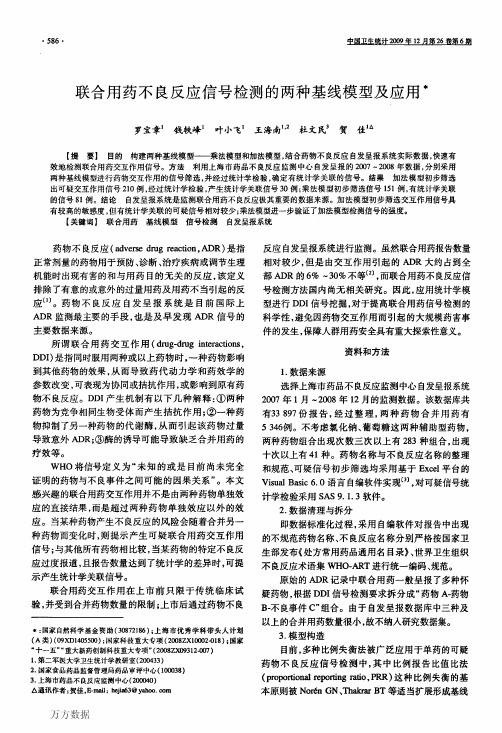
・586・联合用药不良反应信号检测的两种基线模型及应用幸罗宝章1钱轶峰1叶小飞1王海南1・2杜文民3贺佳1△【提要】目的构建两种基线模型——乘法模型和加法模型,结合药物不良反应自发呈报系统实际数据,快速有效地检测联合用药交互作用信号。
方法利用上海市药品不良反应监测中心自发呈报的2007~2008年数据,分别采用两种基线模型进行药物交互作用的信号筛选,并经过统计学检验,确定有统计学关联的信号。
结果加法模型初步筛选出可疑交互作用信号210例,经过统计学检验,产生统计学关联信号30例;乘法模型初步筛选信号151例,有统计学关联的信号8l例。
结论自发呈报系统是监测联合用药不良反应极其重要的数据来源。
加法模型初步筛选交互作用信号具有较高的敏感度,但有统计学关联的可疑信号相对较少;乘法模型进一步验证了加法模型检测信号的强度。
【关键词】联合用药基线模型信号检测自发呈报系统药物不良反应(adversedrugreaction,ADR)是指正常剂量的药物用于预防、诊断、治疗疾病或调节生理机能时出现有害的和与用药目的无关的反应,该定义排除了有意的或意外的过量用药及用药不当引起的反应…。
药物不良反应自发呈报系统是目前国际上ADR监测最主要的手段,也是及早发现ADR信号的主要数据来源。
所谓联合用药交互作用(drug—druginteractions,DDI)是指同时服用两种或以上药物时,一种药物影响到其他药物的效果,从而导致药代动力学和药效学的参数改变,可表现为协同或拮抗作用,或影响到原有药物不良反应。
DDI产生机制有以下几种解释:①两种药物为竞争相同生物受体而产生拮抗作用;②一种药物抑制了另一种药物的代谢酶,从而引起该药物过量导致意外ADR;③酶的诱导可能导致缺乏合并用药的疗效等。
WHO将信号定义为“未知的或是目前尚未完全证明的药物与不良事件之间可能的因果关系”。
本文感兴趣的联合用药交互作用并不是由两种药物单独效应的直接结果,而是超过两种药物单独效应以外的效应。
药品不良反应信号检测方法理论及应用研究

药品不良反应信号检测方法理论及应用研究【摘要】我国的国家药品不良反应监测中心成立于1998年,主要依靠自发呈报系统收集药品不良反应。
SRS是目前世界上最主要的ADR监测手段,也是ADR信号的最主要来源。
所谓的ADR信号指的是药品与不良事件间可能存在因果关系的报告信息,这种关系是未知的或者以前的文献资料不能充分证实的。
我国目前针对SRS数据库的信号检测工作基本上依靠专家人工完成,随着报表数量的日益增加,对于ADR数据的手工统计分析工作及专家评价的局限性开始显现,如主观偏差、耗时长、效率低下、时间滞后等。
如果能够利用计算机技术结合药物流行病学及统计学方法,对数据库中的巨大信息量进行高效率的信息分析与ADR数据挖掘工作,信号检出速度无疑可以比人工操作大大提高,从而更早使政府做出预警反应。
因此建立一套可直接用于我国SRS数据库的ADR信号自动检测及预警系统,显得迫在眉睫。
【关键词】药品不良反应;信号检测;理论;应用前言本文研究标准化整理药品不良反应数据库,统一药品通用名称和药品不良反应名称这两类指标。
在规整后的数据库和模拟数据库的基础上,比较各信号检测方法。
并将贝叶斯神经网路模型应用到药品不良反应监测数据库中,建成相应的信号检测及预警模块。
1.信息标准化为促进药品不良反应,自发呈报系统数据库的信息标准化建设,收集的41619条数据进行规范化整理。
结合第15版新编药物学与MCDEX药物临床信息参考对数据库中的6万多条的药品通用名称进行规范化整理。
结合WHO的不良反应术语集和ICD-10国际疾病系统分类规整41619条ADR记录。
最终建立了5407个药品通用名称规则名,形成4031个药品通用名称标准名。
建立了8715个不良事件名称规则名,形成2332个不良事件名称标准名。
建立的规则库能自动完成新入库病例的80%的规范化工作。
数据标准化将不规范的习惯用语转化成标准化信息,为数据利用如信号检测和数据挖掘提供了基础。
药品不良反应比例失衡分析方法信号检测中扬名偏倚及其影响
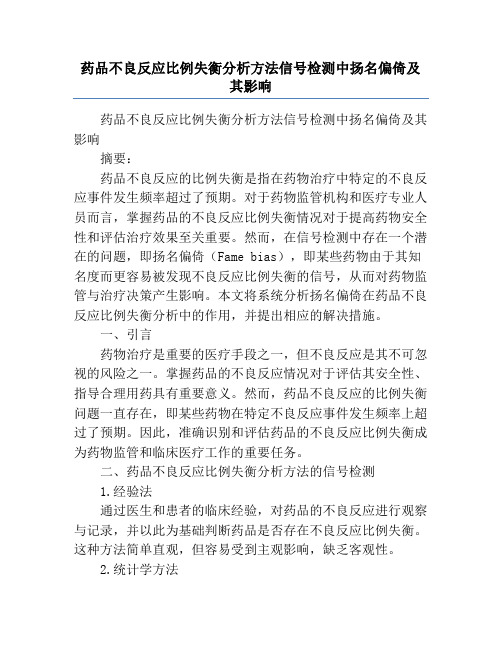
药品不良反应比例失衡分析方法信号检测中扬名偏倚及其影响药品不良反应比例失衡分析方法信号检测中扬名偏倚及其影响摘要:药品不良反应的比例失衡是指在药物治疗中特定的不良反应事件发生频率超过了预期。
对于药物监管机构和医疗专业人员而言,掌握药品的不良反应比例失衡情况对于提高药物安全性和评估治疗效果至关重要。
然而,在信号检测中存在一个潜在的问题,即扬名偏倚(Fame bias),即某些药物由于其知名度而更容易被发现不良反应比例失衡的信号,从而对药物监管与治疗决策产生影响。
本文将系统分析扬名偏倚在药品不良反应比例失衡分析中的作用,并提出相应的解决措施。
一、引言药物治疗是重要的医疗手段之一,但不良反应是其不可忽视的风险之一。
掌握药品的不良反应情况对于评估其安全性、指导合理用药具有重要意义。
然而,药品不良反应的比例失衡问题一直存在,即某些药物在特定不良反应事件发生频率上超过了预期。
因此,准确识别和评估药品的不良反应比例失衡成为药物监管和临床医疗工作的重要任务。
二、药品不良反应比例失衡分析方法的信号检测1.经验法通过医生和患者的临床经验,对药品的不良反应进行观察与记录,并以此为基础判断药品是否存在不良反应比例失衡。
这种方法简单直观,但容易受到主观影响,缺乏客观性。
2.统计学方法利用统计学分析方法,通过大样本的患者信息和事件发生数据,计算药品不良反应的比例以及与预期比例的差异,从而判断是否存在不良反应比例失衡。
这种方法客观可靠,但需要充分的数据支持,且计算复杂。
三、扬名偏倚及其对药品不良反应比例失衡分析的影响扬名偏倚是指由于某些知名度高的药品更容易引起关注,从而使其不良反应比例失衡信号更容易被发现。
这种偏倚可能导致低知名度的药品不良反应被忽视,而高知名度的药品不良反应被过度关注,影响了药物监管与治疗决策的准确性。
扬名偏倚主要产生于以下几个方面:1.广告和宣传知名药品通常拥有大量的广告和宣传资源,可以更容易引起医生和患者的关注,因此其不良反应比例失衡信号更容易被发现。
药品不良反应比例失衡分析方法信号检测中扬名偏倚及其影响
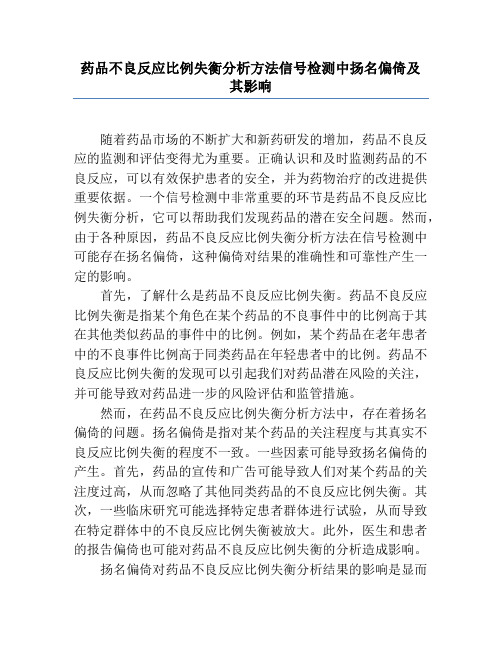
药品不良反应比例失衡分析方法信号检测中扬名偏倚及其影响随着药品市场的不断扩大和新药研发的增加,药品不良反应的监测和评估变得尤为重要。
正确认识和及时监测药品的不良反应,可以有效保护患者的安全,并为药物治疗的改进提供重要依据。
一个信号检测中非常重要的环节是药品不良反应比例失衡分析,它可以帮助我们发现药品的潜在安全问题。
然而,由于各种原因,药品不良反应比例失衡分析方法在信号检测中可能存在扬名偏倚,这种偏倚对结果的准确性和可靠性产生一定的影响。
首先,了解什么是药品不良反应比例失衡。
药品不良反应比例失衡是指某个角色在某个药品的不良事件中的比例高于其在其他类似药品的事件中的比例。
例如,某个药品在老年患者中的不良事件比例高于同类药品在年轻患者中的比例。
药品不良反应比例失衡的发现可以引起我们对药品潜在风险的关注,并可能导致对药品进一步的风险评估和监管措施。
然而,在药品不良反应比例失衡分析方法中,存在着扬名偏倚的问题。
扬名偏倚是指对某个药品的关注程度与其真实不良反应比例失衡的程度不一致。
一些因素可能导致扬名偏倚的产生。
首先,药品的宣传和广告可能导致人们对某个药品的关注度过高,从而忽略了其他同类药品的不良反应比例失衡。
其次,一些临床研究可能选择特定患者群体进行试验,从而导致在特定群体中的不良反应比例失衡被放大。
此外,医生和患者的报告偏倚也可能对药品不良反应比例失衡的分析造成影响。
扬名偏倚对药品不良反应比例失衡分析结果的影响是显而易见的。
首先,由于关注度的不一致,扬名偏倚可能导致对不良反应比例失衡的药品的监测和评估不充分。
一些潜在的风险可能因此被忽视,从而延误了对药品安全的重要决策。
其次,扬名偏倚可能会导致结果的不准确性和误导性。
若以某个药品的不良反应比例失衡作为评估其安全性的唯一依据,可能会得出错误的结论,产生不必要的风险。
为了减少药品不良反应比例失衡分析方法中的扬名偏倚,有几点建议。
首先,应加强对药品不良反应比例失衡分析方法的宣传和培训,提高各方对该方法的认识和理解。
基于BCPNN法的药品不良反应信号检测与自动预警技术研究

摘 要 : 针对目前我国药品不良反应 (ADR)信号检测与自动预警存在的问题 ,在分析当前各种 ADR 信号检测 方法的基础上 ,研究并建立了基于 BCPNN 法和 SRS数据库的 ADR信号检测算法模型 ,应用 Java语言开发了药 品不良反应信号检测与自动预警程序 ,最后通过应用实例说明了上述方法的有效性 。 关键词 : 药品不良反应 ; 贝叶斯信念神经网络法 ; 自发呈报系统数据库 ; 信号检测 ; 自动预警 中图分类号 : TP277; TP391 文献标志码 : A 文章编号 : 100123695 (2009) 0421394204
单且不需要分母 ; ROR 则考虑了在所研究事件出现之前受试 者暴露于药物的时间 ,因而更有价值 ,并对数据的观察更深一 步 ,但使用 ROR 法首先要积累一定量的数据 ,并制定术语词 典 ,然后才能在其多个水平进行信号生成 ;皮尔森 x2值又称做 皮尔森积差相关 ,即以数量化的方式来表达变量相关的大小与 方向 ; BCPNN 是用于描述变量之间相互依赖性关联的概率分 布 ,该网络能够描述各属性子集之间有条件的相互独立 ,它提 供了一个图形模型来描述其中的因果关系 ,这一图形模型就称 为贝叶斯信念网络 ; FDA 使用的 GPS法则是集合了贝叶斯估 计 、伽玛分布及泊松分布三种方法来对信号强度进行评估 [3 ] 。
- 1、下载文档前请自行甄别文档内容的完整性,平台不提供额外的编辑、内容补充、找答案等附加服务。
- 2、"仅部分预览"的文档,不可在线预览部分如存在完整性等问题,可反馈申请退款(可完整预览的文档不适用该条件!)。
- 3、如文档侵犯您的权益,请联系客服反馈,我们会尽快为您处理(人工客服工作时间:9:00-18:30)。
上海市ADR数据库中神经系统药物不良反应的信号检测发表时间:2009-9-18 9:37:29 来源:创新医学网推荐刘媛1 程能能1? 杜文民2 王永铭1 (1 复旦大学药学院药理学教研室上海 200032; 2 上海市药品不良反应监测中心上海 200040)LIU Yuan1, CHENG Neng-neng 1△ , DU Wen-ming2 , WANG Yong-ming1(1 Department of Pharmacology, School of Pharmacy, Fudan University , Shanghai , 200032 ; 2 Shanghai Center f or Adverse Drug Reaction Monitoring, Shanghai , 200040 , China)【摘要】背景在药品不良反应(ADR)监测数据库中存在大量已经明确因果关系的神经系统ADR报告,目前的ADR信号定量检测方法不区分数据库中的已知或未知报告。
目的考察已知ADR报告对ADR信号检测效率的影响,并对上海市ADR数据库进行神经系统ADR信号检测。
方法建立ADR信息库以自动判别ADR数据库中的已知ADR报告,采用PRR算法对上海市2004-2007年ADR自发呈报数据库进行信号检测,并计算可解释度以评价检出的信号。
结果 1. 建立了包含1261种药物,4238种药物-事件组合 (drug-event combination, DEC)的神经系统ADR信息库;2.筛除已知ADR报告能提高神经系统ADR信号检出率24.64% ;3.检测计算共产生神经系统ADR信号98条,包括卡培他滨-咽下困难、吗替麦考酚酯-视觉异常、头孢他啶-精神病等值得关注的信号。
结论筛除已知ADR报告能提高神经系统ADR信号的检测效率。
Abstract Background The signal detection for adverse drug reaction (ADR) is usually based on an ADR spontaneous reporting system (SRS) database containing a considerable proportion of known ADR reports. And currently no algorithm of signal detection can generate difference in results between the known and new ADR reports.Purpose To examine the efficiency of ADR signal detectionbased on SRS database while known ADR reports were excluded partially or totally and to identify potential ADR signals of nervous system.Methods An ADR database of nervous system was established, which was used to remark known ADR reports from SRS automatically. ADR signals of nervous system were generated for possible hazards from proportional reporting ratios (PRR). A new measure representing the association between a drug and an AE was created and applied as reference to assist signal evaluation.Results 1. An ADR database of nervous system containing 1261 drugs and 4138 DECs(Drug-effect combinations)was established. 2. Excluding the reports carrying only known ADRs from Shanghai SRS database above greatly improved the signal hit rate of nervous system by 24.64%.3. In total, 98 signals of nervous system were identified from Shanghai SRS database (during year 2004-2007), including Capecitabine-induced dysphagia, Mycophenolatemofetil–induced vision abnormal and ceftazidime–induced phycosis. Conclusions Excluding the reports carrying only known ADRs can improve the efficiency of ADR signal detection of nervous system.一、背景WHO对药品不良反应(adverse drug reactions , ADRs)的定义是:在正常用量和用法情况下,药物在预防、诊断、治疗疾病或调节生理功能时所发生意外的、与防治目的无关的不利或有害的反应。
当前,随着临床用药数量及品种的大幅增加,药物ADR的发生数量也持续上升,由药物ADR产生的药源性疾病已成为全球主要疾病之一。
在所有药物ADR中,发生在神经系统的毒副作用占24.8 - 26.8%[1],显著高于其它系统或组织。
目前已知的引起神经系统ADR的常见药物就达40余种,其中以抗感染药物为主,尤以喹诺酮类和β-内酰胺类最为多见[2]。
药品不良反应(ADR)自发呈报系统(spontaneous reporting system, SRS)是目前世界上最主要的ADR监测手段,也是目前发现ADR信号的最主要来源。
目前全球范围内尚无利用数据挖掘技术,通过ADR自发呈报库数据来探索未知的神经系统ADR信号,及其相关因素的研究报道。
WHO对信号的定义是:药品与不良事件(adverse event, AE)间可能存在因果关系的报告信息,这种关系是未知的或者以前的文献资料不能充分证实的[3]。
我国《药品不良反应报告和监测管理办法》第十五条规定“新药监测期内的药品应报告该药品发生的所有不良反应;新药监测期已满的药品,报告该药品引起的新的和严重的不良反应”。
第二十九条明确指出“新的药品不良反应是指药品说明书中未载明的不良反应”[4]。
目前我国SRS存在的一个普遍现象是:数据库中的ADR报告有相当部分其实是已经明确因果关系、甚至已写入说明书的不良反应。
如上海市2004?2007年SRS数据库中呈报者定义为“已知ADR”的报告占全部报告数的93%以上(图 1)。
这些报告的存在对于神经系统药物不良反应信号的检测产生何种影响目前尚未见报道。
图1 上海市ADR自发呈报库中呈报者定义为“已知ADR”的报告百分比二、方法上海市ADR自发呈报数据库2004-2007年共收集ADR报表38518份,经过数据清理及必要信息提取后,得到包含报告号、药品通用名称及不良反应标准名称三个字段的ADR原数据集。
本研究的信号检测流程如下图所示:图2 信号检测流程图ADR已知库的建立:根据药品说明书及相关文献建立ADR数据库,含药物名称和不良事件名称二个字段。
目前该库包括1854种药物,22606种药物-不良事件组合(DEC)。
神经系统ADR已知库的建立:根据《WTO药品不良反应术语集》对药品不良反应的分类[5],从ADR已知库中挑选出中枢及外周神经系统损害及神经紊乱两个类别的ADR,组成神经系统ADR已知库,包括4138种DEC,涉及1261种药物。
报告筛选方法:将原数据集ADR报告全部拆分为药物-不良事件组合,与已知数据库逐一比对,保留含有任一新的组合的报告的全部信息。
本研究采用的信号检测算法——PRR法是最早且最基本的信号检测算法。
其基本原理是:PRR=数据库中目标药物引起目标事件的实际报告比/数据库中目标事件的背景报告比,当PRR显著大于1时,则认为该目标药物-目标事件为一信号。
英国药品和保健产品管理局(medicines and healthcare products regulatory agency, MHRA)将PRR值与目标药物-目标事件报告数(a)及皮尔森卡方(?2)值三者结合起来,作为常规的ADR信号检测方法,称为MHRA 法[6,7]。
目前, 该方法已被荷兰的药物警戒中心, 英国的药物ADR监测系统, 世界卫生组织的药物ADR监测中心(WHO,UMC)及美国的药物ADR自发报告系统广泛应用[8]。
表1 信号检测的四格表目标事件其他事件目标药物 a b其他药物 c dMHRA法信号判别标准:PRR>2,a>2, ?2>4其中:PRR=a(c+d)/(c(a+b)),?2=n(|ad-bc|-n/2)2/(a+b)(a+c)(b+c)(c+d), n=a+b+c+d对于一个目标DEC而言,目标事件可能是目标药物单独引起,也可能是与目标药物联用的其他药物引起的。
按报告数进行四格表的计数时,这2种情况的信号值完全相同。
因此我们提出一个信号的参考指标——可解释度,其定义为含目标DEC报告中已知能引起目标事件的报告数/含目标DEC的报告总数。
这一指标可作为估计信号的价值的参考,可解释度越低,目标事件可归因于目标药物的可能性就越大。
三、结果上海市ADR自发呈报数据库2004-2007年报告共38518份,可用于信号检测计算的有效报告共38438份(即原数据集),报告频数3以上的组合14184种,涉及药物1237种,不良事件393种。
其中含有神经系统药物不良反应的报告4725份,占12.29%,出现频次最高的神经系统不良事件依次是头晕(2082)、头痛(768)、局部麻木(424)、失眠(157)与耳鸣(141)。
经总已知ADR库筛选后得到的新数据集A含有报告18182份,报告频数3以上的组合2339种,涉及药物913种,不良事件381种。
经神经系统已知ADR库筛选后得到的新数据集B含有报告37824份,报告频数3以上的组合3156种,涉及药物966种,不良事件392种。
